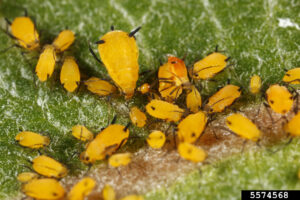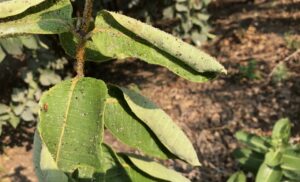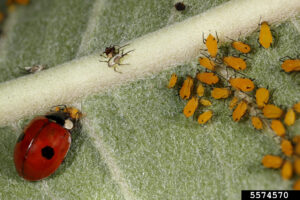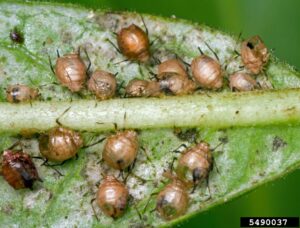Bright yellow or orange aphids covering a milkweed plant may look shocking, but they usually aren’t a cause for concern. These aphids become more noticeable in late summer or when plants are stressed. Some may find them unsightly, but, for the most part, they cause little to no harm to plants or beneficial insects on milkweeds.
What are they?
Milkweed aphids (also known as oleander aphid; Aphis nerii) are a non-native insect commonly found feeding on the sap of milkweed and butterfly weed. They are bright yellow or orange with black legs (image 1). These aphids can blanket leaves, stocks, or seed pods and can reproduce quickly making it seem like they appear overnight (image 2). Plants that are stressed or over fertilized are more likely to be infested with these aphids. However, they also increase in number in the late summer as plants are naturally moving into decline as fall approaches.
- Milkweed aphids are easily recognized by their bright yellow to orange color and their black legs. Photo by Joseph Berger.
- Milkweed aphids can cover large surfaces of milkweed plants. They leave behind papery white specks when they molt often giving the impression of two species occurring on a plant. Photo by Cliff Sadof, Purdue University.
Why are they so brightly colored?
Like monarch butterflies, the coloration of these aphids is a warning sign to predators that they are toxic. This causes some predators to avoid them, but many like lacewings, ladybug larvae, and some parasitoids still eat them (image 3). Indeed, it is common to find hard, dry, brown aphids mixed in with the yellow ones (image 4). These aphids have been parasitized and should be left on the plant to support the population of milkweed aphid predators.
- Many predators avoid milkweed aphids because of their chemical defense. However, some insects, like ladybugs, are able to eat them. Photo by Joseph Berger
- Aphids that have been killed by parasitoids become brown, papery, and hard. These aphids house a growing parasitoid that will hatch and kill more aphids. Photo by David Cappaert.
Will they harm monarch butterflies or caterpillars feeding on milkweed?
Milkweed aphids do not directly harm monarchs. They don’t eat monarch eggs nor do they attack the caterpillars. Although aphids may affect monarch caterpillars by weaking the milkweed and making it easier for caterpillars to eat or competing with caterpillars for milkweed, these impacts are relatively minor. Overall, it’s more likely that monarchs will be harmed by efforts to remove the aphids than that they will be harmed by the aphids themselves.
Do they harm plants?
In most cases, milkweed aphids are not a problem for plant health. Occasionally, they may cause deformities in flowers or stunt plant growth, but this is rare. Milkweed aphids also produce enough honeydew (sugary liquid excrement) to give the leaves a sticky shine and promote the growth of sooty mold. The black sticky mess on leaves is unsightly, but it does not seriously harm milkweed health.
To manage or not to manage?
Milkweed aphids can look alarming but they do little to no damage to plants and have minimal direct impact on pollinators. In most cases, treatment is not necessary and runs the risk of injuring beneficial insects. However, in cases where management is required, manually removing the aphids or treating them with horticultural soap is the best option provided it is done carefully and with consideration of the other insects on the plant. Check plants before treating them and if you find any other insects, remove them and either place them in a jar until you are finished or move them to a new, safe milkweed.
Cover image by William M. Ciesla, Forest Health Management International



